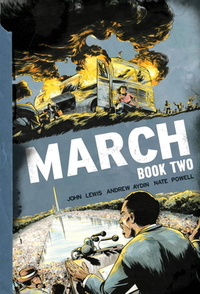You need to sign in or sign up before continuing.
Take a photo of a barcode or cover
Such an accessible way to learn about John Lewis and the Civil Rights Movement. I teach this with my 11th graders and they love engaging with it.
I'm learning more about the civil rights movement from the March graphic novels than I ever learned in school. Incredible, powerful memories from John Lewis.
informative
inspiring
reflective
medium-paced
I enjoyed it. The ending set up the third book well. Not as conceptually strong as the first book
Book Two takes us deep into the struggle and doesn’t hold back. The graphic novel suits this story so well because the violence is depicted without pulling punches. I’m grateful to have read about the horrific pains, beatings and injustices that the Freedom Riders and civil rights protestors endured to draw attention to the cause. What an incredible book.
Incredibly powerful and inspiring. It was especially moving how the narrative shifts between the civil rights movement and the inauguration of President Obama. I cannot recommend this enough.
I've been meaning to pick up this second book in the series for a while, and now felt like a good time. There is so much to this story that I never learned in school. The Civil Rights movement was more than just MLK giving a good speech in Washington, D.C. -- and it has been incredible to learn about the key players of this movement. The storytelling is so compelling, and the art is INCREDIBLE. I cannot recommend this enough.
These books are giving me hope. I think I'll try to teach them in my IRW class.
adventurous
emotional
informative
fast-paced
From my review on Book One and still applicable here:
I (like a lot of other people) first heard about this graphic novel after Donald Trump's disparaging remarks towards John Lewis and it sold out on Amazon. I patiently waited for my copy to come in to the library, and I had pretty high expectations because of the hype. In the end, though, I found it to be just OK.
To be clear, I think what John Lewis did for the Civil Rights Movement was incredibly important and couldn't even be properly be reflected on a 5 star scale, but my rating is based on how that story was told. I didn't realize before reading this that it is aimed at a young adult audience, but I tried to keep that bias out of my final rating.
Out of the three volumes in the series, I think I learned the most from this one. While the Freedom Riders were briefly covered in school, I had never learned the harrowing details of their work. I did find the writing a bit clunky and, again, I think the graphic novel could easily have been a generic overview with minor changes. I spent a lot more time trying to keep track of the various organizations involved that what Lewis himself specifically did. (This is another time I think adding color could've contributed to the narrative if it had been used to help differentiate between each group.)
And just like the last volume, I feel quite a bit of emotional disconnect from the story. Maybe it's because I knew the "ending," but I couldn't quite feel the despair or fear the characters/people were experiencing. I was also still bothered by the wonky heads of figures I recognized - I wish I knew why this artistic choice was made.
I (like a lot of other people) first heard about this graphic novel after Donald Trump's disparaging remarks towards John Lewis and it sold out on Amazon. I patiently waited for my copy to come in to the library, and I had pretty high expectations because of the hype. In the end, though, I found it to be just OK.
To be clear, I think what John Lewis did for the Civil Rights Movement was incredibly important and couldn't even be properly be reflected on a 5 star scale, but my rating is based on how that story was told. I didn't realize before reading this that it is aimed at a young adult audience, but I tried to keep that bias out of my final rating.
Out of the three volumes in the series, I think I learned the most from this one. While the Freedom Riders were briefly covered in school, I had never learned the harrowing details of their work. I did find the writing a bit clunky and, again, I think the graphic novel could easily have been a generic overview with minor changes. I spent a lot more time trying to keep track of the various organizations involved that what Lewis himself specifically did. (This is another time I think adding color could've contributed to the narrative if it had been used to help differentiate between each group.)
And just like the last volume, I feel quite a bit of emotional disconnect from the story. Maybe it's because I knew the "ending," but I couldn't quite feel the despair or fear the characters/people were experiencing. I was also still bothered by the wonky heads of figures I recognized - I wish I knew why this artistic choice was made.








